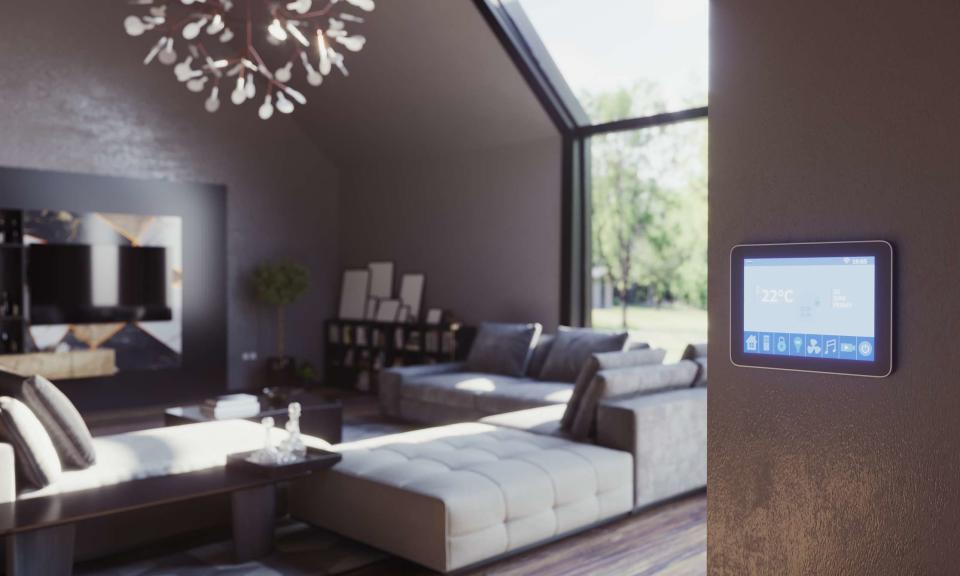What Is a Smart Home?
The Pros and Cons of Home Automation

Eoneren / Getty Images
Fact checked by Sarah Scott
It’s no surprise that as technology continues to advance and change our daily lives, integrations and automations for the home have become more and more common. This has created a rise in the use of the term smart home, but it’s worth noting that the functionality and features of a smart home can vary widely.
In this article, learn what is involved in creating a smart home, what the technology enables you to do, and how much it costs to outfit a home with some of the most popular features.
What Is In a Smart Home?
A smart home is a house in which anything electric, such as appliances, lights, locks, cameras, televisions, and other objects, are connected through the internet to share information. Referred to as the Internet of Things, or IoT devices, you can remotely access and control connected devices through an app on a smartphone or tablet, or a smart home hub—such as Alexa or Google Assistant.
Having a connected network of devices means that you can control aspects of your home with your voice or the touch of a button. You can even monitor or adjust the settings of home appliances or devices when you are away. For example, you can remotely unlock the door for the dog walker or turn off the sprinkler system if it starts to rain outside.
A plethora of advanced options are available that work across multiple smart home platforms and hubs, including Amazon Alexa, Apple HomeKit, Ring, and more. Smart light bulbs, outlet plugs, refrigerators, thermostats, televisions and speakers, doorbells, and a slew of other devices are all available to talk with each other, connecting the home on a scale never seen before.
Smart homes can function based on timer settings or controlled by AI. With these options, you can have your home working for you. For example, you can set the coffee maker and the kitchen lights to turn on when you wake up, or your front door to unlock as you approach your home. For smart homes equipped with AI, appliances can learn your habits and adjust settings to your preferences, such as lowering the thermostat at night or switching on your reading lamp.
Pros and Cons of Home Automation
There are many benefits and a few downsides of having a smart home.
Convenient features help lower the use of electricity and natural resources, making smart homes a greener option. By automating the home’s daily cycles, smart homes add an extra layer of efficiency, security, and comfort to daily living. Smart home devices can also increase the safety of your home with things like motion detectors, smart locks, and doorbell cameras. The biggest pro, however, is the convenience. Having a smart automated home often means you can control settings from one place, like an app on your phone, and even do so remotely. Being able to access all of your devices from one place keeps things streamlined and easier to manage.
When it comes to cons of home automation, the biggest is the initial cost. Investing in smart home devices can be a bigger upfront cost to be able to save more money in the long run. These devices also rely on an internet connection, so if wifi goes out, you might experience outages or difficulty accessing. Finally, while the devices are often more user-friendly, if you aren't tech-savvy, they may feel intimidating to use/install at first glance.
Creating a Smart Home
Creating a smart home can be as simple or as complex as you like. For anyone wanting to stay small and test the waters, starting with a voice assistant and a few smart devices, such as some light bulbs and an outlet plug or two, is a great option. This allows you to incorporate IoT devices without making a major investment. In truth, there are many smart home devices you may not even need.
For those ready to make the big switch, smart options are available for almost any home appliance, including thermostats, refrigerators, washers and dryers, ovens, garage doors, doorbells, and many more. A fully smart home can sense your arrival, open the door for you, turn on the lights and your favorite song, and order more eggs before you run out—all without you needing to do a thing.
As you can see, some smart home modifications are simple, like installing a light bulb that can change to virtually any hue you desire and be remotely controlled from your phone. Other smart home improvements require a larger commitment, such as replacing appliances or running wires in your home. The good news, however, is that serious renovation work is not needed to create an efficient smart home.
Cost of a Smart Home
The cost of a smart home varies just as much as the options of smart appliances do. Wireless options will be less expensive than wired options. Small items, such as light bulbs or smart plugs, will be relatively inexpensive. Typically, you can make these smart home swaps for less than $20.
To build a starter smart home package that includes things like a voice assistant or hub, wireless doorbell or lock, and security camera, may cost a few hundred dollars. Large appliances, such as a refrigerator or washing machine, are often a few thousand dollars each or more. Therefore, the cost of your smart home largely depends on your own preferences and goals, making smart home elements readily available to everyone.
Read the original article on The Spruce.

